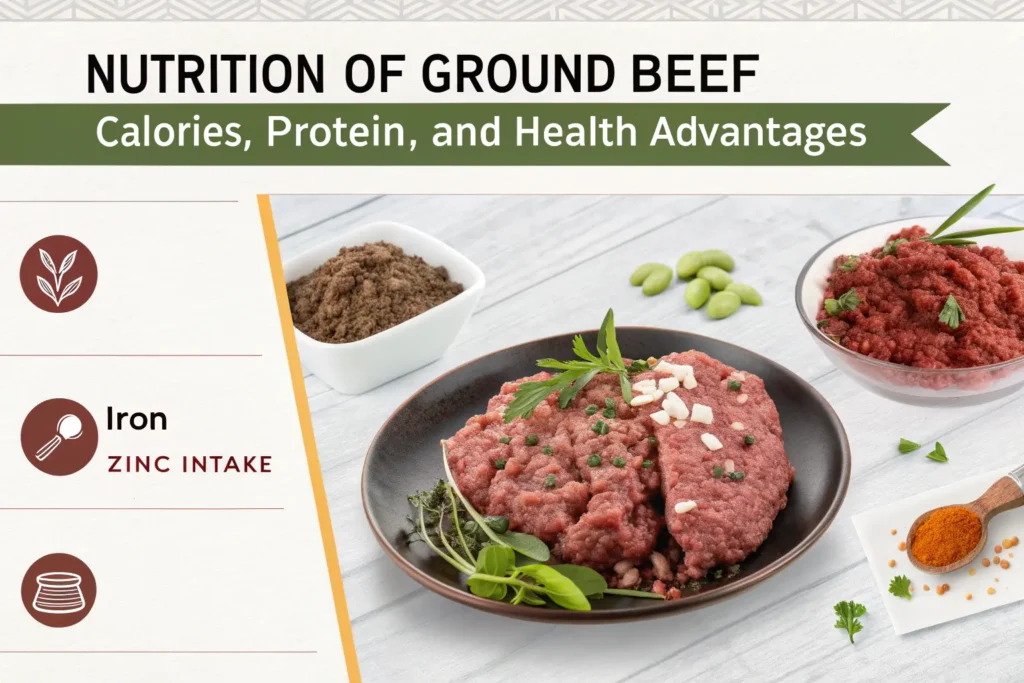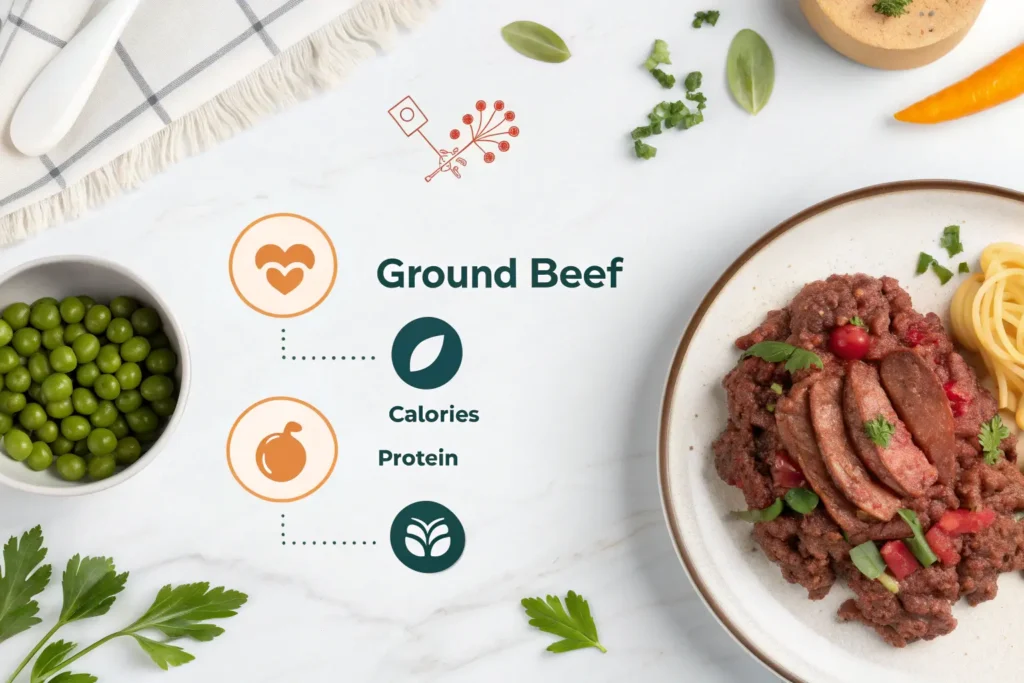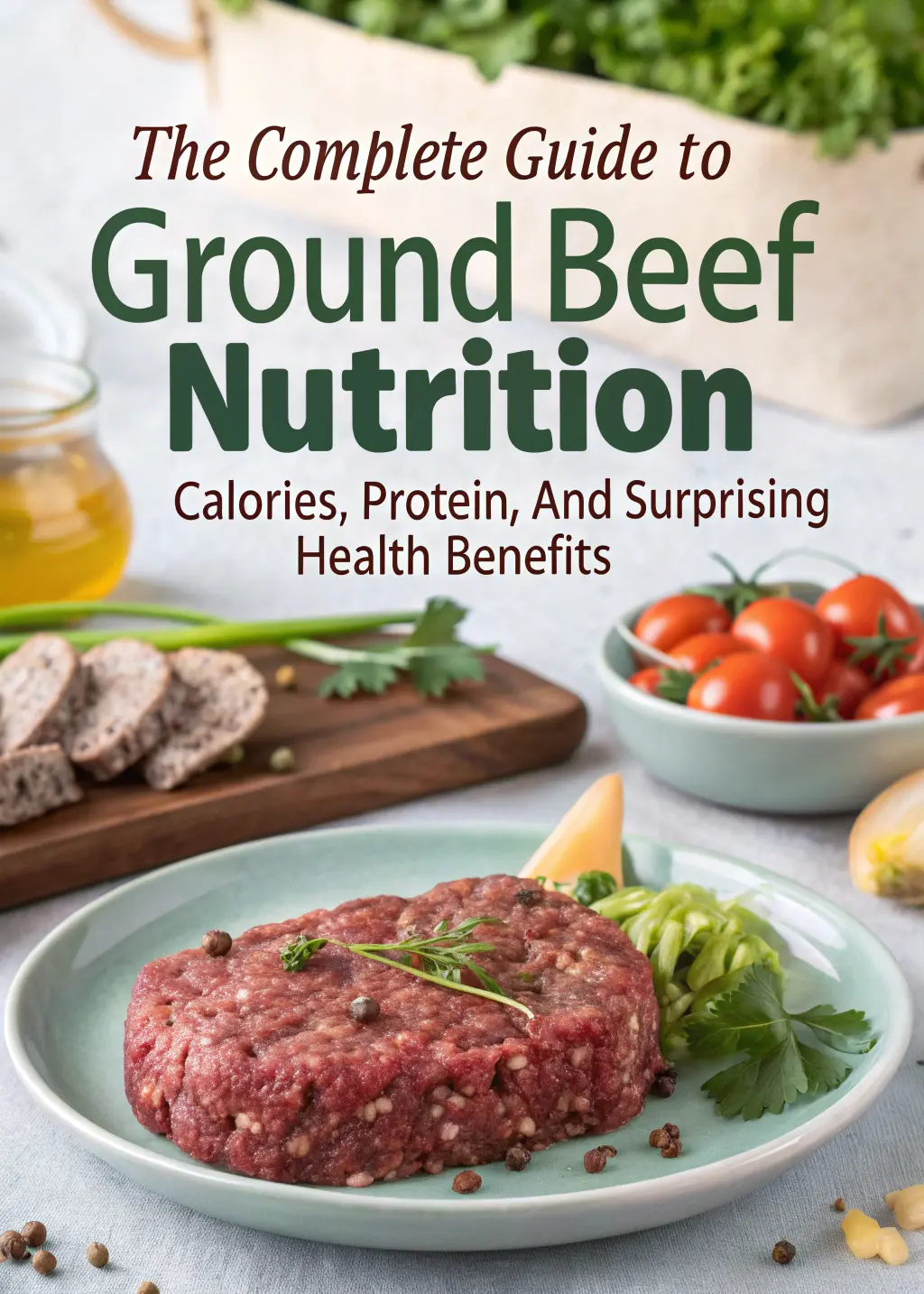The Complete Guide to Ground Beef Nutrition: Calories, Protein, and Surprising Health Benefits
Introduction: My Journey with Ground Beef
Remember those kitchen aromas that instantly transport you back to childhood? For me, it’s the rich, savory scent of ground beef sizzling in my mother’s cast-iron skillet. Those humble pounds of ground beef stretched our family budget while filling our bellies with satisfying meals that brought everyone to the table. Little did I realize then what nutritional powerhouses those simple meals actually were.
Years later, after diving into nutrition research and meal planning for my own family, I’ve come to appreciate ground beef beyond its wallet-friendly price tag and versatility. This kitchen staple offers an impressive nutritional profile that deserves recognition in our contemporary food conversations. Whether you’re building muscle, managing your weight, or simply trying to feed your family nutritious meals, understanding ground beef nutrition might reshape how you view this pantry staple.
Table of contents

Understanding Ground Beef: What Makes It a Staple in American Kitchens
Ground beef remains one of America’s most beloved protein sources, with the average American consuming approximately 55 pounds annually. This versatile meat consists of beef trimmings that have been ground into various textures, from coarse to fine, depending on its intended use.
What truly sets ground beef apart is its classification system based on lean-to-fat ratios. When you spot labels like “80/20” or “93/7,” these numbers represent the percentage of lean meat versus fat content. The first number indicates lean meat percentage, while the second represents fat. This straightforward system helps you make informed choices based on your nutritional needs and recipe requirements.
American kitchens embrace ground beef for good reason—few ingredients transition so seamlessly between cuisines and cooking methods. From Italian-inspired meatballs to Mexican tacos, from grilled burgers to hearty meatloaf, ground beef adapts to whatever culinary direction your meal takes.
The Complete Nutritional Profile of Ground Beef
Macronutrient Breakdown of Ground Beef
The nutritional content of ground beef varies significantly depending on its fat percentage. Here’s how different varieties stack up per 3-ounce cooked serving:
| Nutrient | 73% Lean | 80% Lean | 85% Lean | 90% Lean | 93% Lean |
|---|---|---|---|---|---|
| Calories | 235 | 215 | 197 | 173 | 152 |
| Protein (g) | 22 | 23 | 24 | 24 | 25 |
| Total Fat (g) | 17 | 14 | 12 | 9 | 7 |
| Saturated Fat (g) | 6.2 | 5.3 | 4.8 | 4.1 | 3.1 |
| Cholesterol (mg) | 74 | 71 | 69 | 65 | 62 |
| Sodium (mg) | 66 | 65 | 64 | 63 | 62 |
Notice how protein content actually increases slightly as fat decreases—contrary to what many assume about leaner meats. This makes leaner ground beef particularly valuable if you’re seeking to maximize protein while minimizing calories.
Essential Vitamins and Minerals in Ground Beef
Beyond macronutrients, ground beef delivers an impressive array of micronutrients your body needs:
| Vitamin/Mineral | Amount (in 3oz 85% lean) | % Daily Value |
|---|---|---|
| Vitamin B12 | 2.1 mcg | 88% |
| Zinc | 5.2 mg | 47% |
| Iron | 2.4 mg | 13% |
| Niacin | 5.1 mg | 32% |
| Vitamin B6 | 0.3 mg | 18% |
| Selenium | 17.7 mcg | 32% |
| Phosphorous | 171 mg | 17% |
These numbers reveal why nutritionists often highlight ground beef’s micronutrient density. Just one serving provides nearly your entire day’s requirement of vitamin B12—crucial for neurological function and energy production.
Protein Power: Why Ground Beef Is a Complete Protein Source
Not all proteins are created equal, and ground beef stands among the elite “complete proteins.” This designation means it contains all nine essential amino acids your body cannot produce independently. While plant proteins often lack one or more essential amino acids, requiring careful combinations to meet nutritional needs, ground beef delivers the complete package in one ingredient.
The protein quality in ground beef exceeds most plant sources not only in amino acid profile but also in digestibility. Your body absorbs approximately 94% of protein from beef, compared to 75-85% from most plant sources. This superior absorption rate makes beef protein particularly valuable for:
- Supporting muscle maintenance during weight loss
- Accelerating recovery after intense physical activity
- Promoting satiety, helping you feel fuller longer
- Sustaining stable blood sugar levels between meals
- Bolstering immune function through antibody production
A moderate 3-ounce serving of ground beef (roughly the size of a deck of cards) provides nearly half the daily protein requirement for most adults—an impressive nutritional density few foods can match.
Calories in Ground Beef: Making Informed Choices
Understanding calorie content helps you incorporate ground beef into any dietary approach. The significant calorie variation between different lean-to-fat ratios gives you flexibility in managing your intake:
For weight management: Choose 90% or 93% lean varieties, which provide maximum protein with minimal calories.
For building meals with staying power: 85% lean ground beef offers a balanced approach, with enough fat for flavor and satiety.
For special occasions where flavor reigns supreme: 80% or 73% lean varieties deliver richer taste and juiciness for dishes like gourmet burgers.
Your cooking method also impacts caloric content. Grilling or broiling ground beef allows excess fat to drip away, potentially reducing calories by 10-15% compared to the raw values. Conversely, pan-frying without draining retains most fat, keeping calorie content closer to packaging estimates.

The Health Advantages of Including Ground Beef in Your Diet
Essential Nutrients Found Abundantly in Ground Beef
Ground beef’s nutritional profile includes several standout nutrients that deserve special attention:
Heme Iron: Unlike plant-based iron sources, beef contains highly bioavailable heme iron—your body absorbs approximately 15-35% of heme iron compared to just 2-20% from plant sources. This makes ground beef particularly valuable for menstruating women, growing children, and athletes whose iron needs exceed average requirements.
Zinc: With nearly half your daily zinc requirement in one serving, ground beef supports immune function, wound healing, and proper hormone production. Research links adequate zinc intake to shorter cold durations and enhanced taste perception—important for enjoyment of diverse foods.
B Vitamin Complex: Ground beef delivers a powerhouse of B vitamins, including B12 (crucial for nerve function and red blood cell formation), niacin (supporting energy metabolism), and B6 (involved in over 100 enzyme reactions in your body). These nutrients work synergistically to convert food into usable energy and maintain neurological health.
Beyond these prominent nutrients, ground beef contains lesser-known beneficial compounds including creatine (supporting brain function and athletic performance), carnosine (a powerful antioxidant), and conjugated linoleic acid (potentially beneficial for insulin sensitivity).
Addressing Health Concerns About Ground Beef Consumption
The conversation around red meat consumption continues evolving as research advances. Contemporary nutritional science takes a more nuanced view than previous decades:
Recent large-scale meta-analyses have questioned previous associations between moderate red meat consumption and cardiovascular disease when controlling for other dietary and lifestyle factors. The current evidence suggests that lean beef, consumed as part of a varied diet rich in vegetables, whole grains, and healthy fats, fits comfortably within heart-healthy eating patterns.
Quality significantly impacts nutritional value. Grass-fed ground beef typically contains higher omega-3 fatty acids, conjugated linoleic acid, and antioxidant vitamins than conventional beef. While these differences don’t transform ground beef into a completely different food, they represent meaningful nutritional enhancements worth considering if your budget allows.
Smart Shopping: Selecting the Best Ground Beef for Your Needs
Navigating meat counter terminology ensures you get exactly what you need:
- “Lean” ground beef must legally contain less than 10 grams of fat per serving
- “Extra lean” contains less than 5 grams of fat per serving
- “Grass-fed” indicates cattle consumed primarily grass, but doesn’t necessarily mean exclusively grass (check for “grass-finished” for lifetime grass feeding)
- Organic certification requires no antibiotics, hormones, or GMO feed, plus access to pasture
Trust your senses when evaluating freshness. Quality ground beef should appear bright red (though vacuum-packed beef often looks purplish until exposed to oxygen), smell neutral, and feel slightly firm but not sticky.
For maximum safety, refrigerate ground beef at temperatures below 40°F, use within 1-2 days of purchase, or freeze for up to four months. Always cook ground beef to an internal temperature of 160°F to eliminate potential pathogens.
Cooking Methods That Maximize Nutrition in Ground Beef
Your cooking approach dramatically impacts both the flavor and nutritional profile of ground beef:
- Broiling and grilling allow fat to drip away, reducing overall calorie content while maintaining protein levels
- Pan-searing with draining achieves similar results while developing rich flavor through Maillard reaction
- Baking on a rack permits fat separation similar to grilling
- Simmering in sauce distributes fat throughout the dish but creates exceptional flavor integration
Avoid excessive browning or charring, which can create potentially harmful compounds. Instead, aim for medium-high heat that develops flavor while preserving nutritional integrity.
Balanced Meal Planning with Ground Beef
Creating nutritionally complete meals with ground beef involves thoughtful pairings with complementary foods:
Combine ground beef with:
- Fiber-rich vegetables to enhance satiety and digestive health
- Complex carbohydrates for sustained energy
- Heart-healthy fats from sources like avocados or olive oil
- Colorful produce to boost antioxidant intake
This approach creates meals with balanced macronutrients while broadening the micronutrient spectrum beyond what ground beef alone provides.
Conclusion: Embracing Ground Beef as Part of a Balanced Diet
Ground beef nutrition extends far beyond simple protein content. With its impressive array of essential nutrients—including highly bioavailable heme iron, zinc, and B vitamins—ground beef delivers nutritional benefits that complement a varied diet. By selecting appropriate lean-to-fat ratios, employing healthy cooking methods, and creating balanced meals, you can confidently incorporate this versatile protein into your nutritional approach.
Whether you’re building muscle, supporting active children, or simply seeking satisfying meals that deliver genuine nutritional value, ground beef deserves consideration as more than just an affordable protein option. It represents a nutrient-dense whole food that humans have consumed and thrived upon for countless generations.
Ready to explore ground beef’s potential in your kitchen? Start by experimenting with different lean-to-fat ratios to find your perfect balance between nutrition and flavor. Your body—and your taste buds—will thank you.

Frequently Asked Questions About Ground Beef Nutrition
Is ground beef healthy for weight loss?
Ground beef can support your weight loss goals when you select leaner varieties (90% or leaner) and monitor portion sizes. Its exceptional protein content helps preserve muscle mass during caloric restriction while promoting satiety—keeping hunger at bay between meals. Studies show high-protein diets typically result in greater fat loss than lower-protein alternatives, making ground beef nutrition a valuable component in weight management strategies.
How does the nutrition of ground beef compare to ground turkey?
While both provide quality protein, ground beef nutrition typically includes significantly more iron, zinc, and vitamin B12 than ground turkey. Turkey generally offers fewer calories and less saturated fat, particularly when comparing white meat turkey to beef. Your optimal choice depends on specific nutritional priorities—beef for micronutrient density, turkey for lower calorie content.
Can ground beef be part of a heart-healthy diet?
Leaner ground beef varieties (90% or higher) can absolutely fit within heart-healthy eating patterns when consumed in moderation. Recent nutritional research challenges previous assumptions about saturated fat’s effects, suggesting that the complete nutrition of ground beef—including its zinc, B vitamins, and high-quality protein—contributes positively to overall health when part of a varied diet rich in vegetables, fruits, and whole grains.
What’s the difference in nutrition of ground beef that’s grass-fed versus grain-fed?
Grass-fed ground beef nutrition typically includes up to five times more omega-3 fatty acids, significantly higher conjugated linoleic acid (CLA), and additional antioxidant vitamins compared to conventional grain-finished beef. However, protein content remains comparable between both varieties. These nutritional differences reflect the natural diet cattle evolved to consume, making grass-fed beef potentially worth its premium price for nutrition-focused consumers.
How much ground beef should I eat per week for optimal nutrition without health risks?
Current nutritional guidelines suggest limiting red meat consumption to 3-4 servings weekly (with a serving equaling 3-4 ounces cooked). This moderate approach allows you to benefit from ground beef nutrition while maintaining dietary variety and balancing concerns about higher consumption levels. Your personal factors—activity level, age, overall diet quality—may warrant adjustments to this general recommendation.
Does cooking method affect the nutrition of ground beef?
Cooking techniques significantly impact ground beef nutrition. Grilling and broiling reduce fat content by allowing it to drip away, potentially lowering calories by 10-15%. Methods like pan-frying retain more fat when not drained properly. Regardless of technique, cooking to an internal temperature of 160°F ensures food safety while preserving nutritional quality—avoiding extreme overcooking that might degrade certain nutrients.
Is organic ground beef more nutritious than conventional?
Research indicates modest but meaningful differences in ground beef nutrition between organic and conventional sources. Organic beef typically contains slightly higher omega-3 fatty acids and conjugated linoleic acid, though core nutrients like protein, iron, and B vitamins remain comparable. The primary advantages of organic certification relate to absence of hormones and antibiotics rather than significant nutritional differences.
Have you given our recipe a try?
There are no reviews yet. Be the first one to write one.







